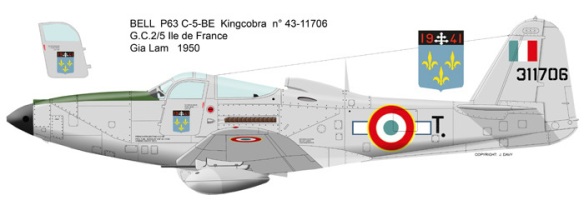
The French Air Force during the Indochina War was employed primarily as a ground-support force. The air force there was reconstituted in 1946 from personnel and aircraft already in Indochina. The latter were a mixture of captured Japanese aircraft as well as British Spitfire and American-made Bell P-63A Kingcobra fighters, German trimotor Junkers JU-52, and American Douglas C-47 Skytrain (“Gooneybird”) transports.
The French built up their air assets as quickly as resources were available. In 1947 additional C-47s and British Mosquito fighter-bombers arrived from Europe. The fragile plywood Mosquito proved unsuitable for Indochina’s climate, however, and was replaced with the American-made Douglas B-26 Invader light bomber, which the United States began to supply to the French in Vietnam. Later in the war Washington sent Grumman F6F Hellcat and F8F Bearcat fighters as well as Fairchild C-119 Flying Boxcar transports. The French also purchased aircraft from a variety of sources, such as the Dutch-manufactured Fokker transport. France also introduced its own Bretagne transports, twin-engine planes equipped with auxiliary wing-tip jet engines for short-terrain takeoff assistance. The French Air Force also experimented with helicopters (American-made Sikorsky H-51s) for medical evacuation and observation.
The French Air Force command was organized into four regional headquarters to support operations throughout Vietnam. Aircraft performed traditional reconnaissance, ground-support bombing and strafing, and airlift activities. Initially aircraft were dispatched in pairs from various air bases to provide limited air support to French units under siege in isolated locations. In 1950 French commander in Indochina General Jean de Lattre de Tassigny reorganized the air force and changed its doctrinal role. French air doctrine now called for increased massed tactical strikes and strategic objectives working in conjunction with the French Army rather than as subordinate to it. From 1950 until the end of the conflict, French fighter-bombers and light bombers flew numerous close air support missions, dropping napalm in support of ground units.
French bombers attempted strategic bombing of Viet Minh targets whenever they were identified; however, the French bomber force played only a small role in the war. As the French began to place more reliance on close air support, the Viet Minh began to adopt tactics and acquire antiaircraft weapons that, as in the case of the Battle of Dien Bien Phu, largely negated their opponent’s air superiority.
Throughout the conflict, the French suffered a chronic shortage of transport aircraft. Transports, crucial to airborne and logistical missions, were always in short supply. They required longer runways and could not easily take off and land on improvised jungle air strips. The shortage of transports proved to be a factor in the French defeat at Dien Bien Phu in 1954. The French did not possess sufficient helicopters or have experience in what would later be termed airmobile warfare to conduct effective helicopter operations.
Although aircrews and ground-support personnel of the French Air Force attempted to provide the French Army with a capability to win the Indochina War, shortages of equipment, maintenance problems, imperfect facilities, and the considerable distances involved as well as a lack of effective doctrine doomed that effort to failure, despite the bravery of the aircrews and ground-support personnel.
References Beckett, Brian. The Illustrated History of the Viet Nam War. New York: Gallery Books, 1985. Bishop, Chris, and Ian Drury, eds. Combat Guns: An Illustrated Encyclopaedia of 20th Century Firearms. Secaucus, NJ: Chartwell Books, 1987. Bonds, Ray, ed. The Vietnam War: The Illustrated History of the Conflict in Southeast Asia. New York: Salamander, 1999. Christienne, Charles, and Pierre Lissarague. A History of French Military Aviation. Translated by Francis Klanka. Washington, DC: Smithsonian Press, 1986. Fall, Bernard B. Hell in a Very Small Place: The Siege of Dien Bien Phu. New York: Lippincott, 1966.